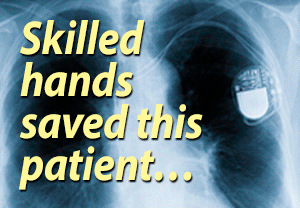 A NEW LEASE ON LIFE.
A NEW LEASE ON LIFE.
- by Stepford_Wife
- 2008-02-21 05:02:04
- General Posting
- 2903 views
- 3 comments
I found this article in Reader's Digest, and I was so fascinated that I had to share it with you.
In the near future, there will be a new protein, like a seed that causes new vessels to sprout, creating a network of capillaries and small arteries.
Could that be the end of open heart bypass surgery, or a cure for CHF?
Please read on.
~ Dominique ~
New Treatment for Heart Transplant Hopefuls
An experimental treatment is giving desperately ill heart patients a new lease on life.
By Lisa Collier Cool
From Reader's Digest
February 2008
Last Resort
Jim Blevins and Gail Keller were heart patients who'd run out of time. They had literally no options leftuntil they volunteered for an experimental procedure, hoping, at least, to help others.
Blevins faced a catch-22 situation in 2004 when he learned that he needed a transplant to survive but wasn't sick enough to qualify for a new heart. His heart problems had started a decade earlier, when he was 42 years old and working as a truck driver for a bread company in Ohio. After work and on weekends, Blevins liked to kick back and coach the local girls' softball team. But he'd been feeling sluggish and exhausted. At the urging of his wife, Janet, he went to his family doctor. His EKG was abnormal, and he was rushed to a cardiologist and then to the ICU.
"That really scared me," Blevins says. "After they did all sorts of tests, a doctor told me I'd had a heart attack. And I hadn't even realized it."
The next morning, Janet and the couple's three daughters were by his side as he was wheeled to the OR for bypass surgery. Because the heart attack had done so much damage, Blevins had to spend a month in the hospital, followed by five more months of outpatient rehabilitation, before he was well enough to start to pick up his life again.
Blevins had no complications for ten years, and then he began to experience shortness of breath and angina, chest pain that strikes when the heart is starved of oxygen-rich blood. He was headed for another heart attack or even sudden death. "I was in constant pain. On a scale of one to ten, it was a six," he says. "I was so short of breath, I couldn't walk from the back door of a grocery store to the bread rack without having to stop and rest.
"When I went to the heart doctor, he said there was nothing more he could do because my arteries were too clogged to put in any more bypasses. He told me I might only live another five years. I was 52 and thought my life was over. My wife and kids were scared to death that they'd lose me. And I was terrified too."
Deadly Predicament
His doctor told him that a heart transplant might help him survive for up to ten years. To see if he qualified, in 2004 Blevins consulted Lynne Wagoner, MD, then director of cardiac services at the University Hospital in Cincinnati. "Jim was what some doctors call a no-option patient," says Dr. Wagoner. "All the conventional treatments had been exhausted, but he didn't meet the criteria for a transplant. There's a shortage of donor organs, and patients have to be so sick that they're on their deathbed to qualify. Many people die while they're waiting for a new heart."
Gail Keller, also a patient of Dr. Wagoner's, was in the same deadly predicament. The 35-year-old from New Paris, Ohio, suffered from an inherited disorder that causes extremely high levels of cholesterol to build up in the blood. It can lead to severe heart disease or sudden death.
Keller was only 16, and a three-sport athlete, when she had a heart attack while doing jumping jacks. By the time she was 19, she had undergone triple-bypass surgery.
"My doctors said I'd never see 21, because they didn't think my arteries would stay open," says Keller. But she remained healthy long enough to graduate from college, earn a master's degree and settle into a career as a rehabilitation counselor for the disabled. "Every year was scary because I felt like I was living on borrowed time."
When Keller turned 33, she got so sick that she had to quit her job and move in with her parents. "Pretty much anything I did brought on chest pain, shortness of breath and terrible fatigue," she says. "It often got so bad that all I could do was lie in bed." When she was evaluated for a heart transplant, in 2002, says Dr. Wagoner, "her arteries were like tiny twigs that nothing could fix. It was amazing that she was still alive. She was extremely impaired and didn't have any quality of life. It was hard to look someone so young in the face and say, Sorry for your bad luck, but we can't help you anymore. All we could do was treat her with medications, knowing it was very likely she'd have another heart attack."
Breakthrough
Then a new breakthrough offered a gleam of hope to Dr. Wagoner's no-option patientsa process called angiogenesis. The experimental procedure had shown great promise in two German studies, and the FDA had approved the launch of the first American clinical trial.
The technique involves injecting the heart with a protein called fibroblast growth factor 1 (FGF-1), explains Thomas Stegmann, MD, the German heart surgeon who pioneered the treatment and brought it to the United States. "The protein is like a seed that causes new vessels to sprout, creating a network of capillaries and small arteries."
FGF-1 occurs naturally in the body, but the effects of injecting it were unknown. Would it have unexpected hazards, such as causing cancer or triggering blood vessel growth in places where it would be dangerous, like the eyes?
Dr. Stegmann initially tested it on animals. The 40 volunteers in his first human study, conducted in 1995, were very ill. Their blockages were so severe, they weren't expected to live more than two years at most. Twenty of them received two injections of the protein, along with standard bypass surgery.
Three months later, X-rays showed new vessels radiating from the injection sites and linking to the existing arteries, doubling or even tripling blood flow to the heart. "We were amazed at how much better the patients were. Some of them even went back to work when they were previously too disabled to lead normal lives," says Dr. Stegmann, who later tested FGF-1 as a sole therapy for 20 no-option patients, with similar increases in flow. In effect, the studies found, the sickest patients were growing their own natural bypasses.
What's more, almost all the once deathly ill patients from the 1995 study were still alive ten years laterand healthy enough to attend a reunion. (Two died of unrelated causes.) "It was touching to see them celebrating and enjoying life," says Dr. Stegmann. Two of the survivors asked if they could be injected again because they'd developed new clogs.
Limited Patient Pool
Since FGF-1 had been tested on only 40 patients, the FDA set stringent rules for Dr. Wagoner's trial, which began in November 2003. Enrollment was limited to patients with heart pain who were too ill to benefit from bypass surgery but weren't so sick that they'd gone into heart failure. And Dr. Wagoner was allowed to treat only a few patients at a time. Then she had to spend 12 weeks evaluating their results before getting approval to inject the next group of patients.
After a week of tests, Keller was accepted into the trial. Dr. Wagoner warned her that the treatment had risks, including anesthesia reactions, growth of unwanted blood vessels elsewhere in the body, uncontrollable bleeding, even death. "I was concerned about the dangers but also thrilled and elated to finally have hope," Keller says. "I had nothing to lose, because the quality of my life was so bad."
On a Monday in late August 2004, John and Joan Keller took their daughter to the hospital. In the OR, she was sedated. Surgeons made an incision, carefully injected FGF-1 into the outside wall of her beating heart, and stitched her chest closed.
Within a week, though still recuperating from the operation, Keller began to notice a difference. "I had less chest pain," she describes, "and everything I did seemed easier."
Over the next several weeks, she felt herself slowly coming back to life. "Instead of getting out of breath after walking ten feet, I could go farther each day," she says. "Then I could go up and down stairs without any problem. And I didn't need to take naps every few hours, because the chronic fatigue was gone."
At first, Jim Blevins was too ill to qualify; his heart was too close to completely failing. But after Dr. Wagoner tried several medications, he improved enough to be accepted. It was March 2005. "Within 24 hours of having the injection, my chest pain was completely gone," Blevins says. "I could hardly believe it."
Home from his three-day hospital stay, Blevins, now 55 and retired, took it easy for six weeks while his incision healed. "After that, I was finding more and more strength. I could mow the lawn without stopping," he says. "I'd been dreading the future, thinking that I'd go into heart failure again and only have a few years left, but within a few months of being treated, my energy was up at least 50 percent. Everyone noticed how much better I was.
"
A New Lease on Life
In 2006 Blevins met Dr. Stegmann at a one-year reunion of the Cincinnati trial participants. "Twenty patients were there," says Blevins. "Some had come from as far away as Texas to get this treatmentand we were all so excited that our lives had been saved." The researchers report no deaths or side effects in the trial, which ended in March 2006.
One of Dr. Wagoner's patients, a middle-aged woman, said that though she initially improved, some of her symptoms returned. But so far both Blevins and Keller have stayed well. "Now I help my mom out a lot when, before, she had to take care of me," says Keller. "I live on my own, on a 73-acre farm, with two dogs and three cats. I work in the garden, growing all my favorite flowers, which I couldn't do before."
And Keller herself has blossomed. "I used to be very depressed," she says, "but these days I keep finding things that make me smile. In the summer, I bought a bicycle and was able to ride for about a mile. It was so coolit was the first time I'd been able to do that in 15 years. Now I bike three or four times a week."
Last August, Keller celebrated a day doctors had predicted she'd never reach: her 40th birthday. Some 60 friends and relatives gathered around her parents' swimming pool for the festivities. "It was such a wonderful day," she says. "People were teasing me about being over the hill. That was funny because I feel so much younger than I did before. There was a big table covered with gifts. My parents brought out the most beautiful birthday cake. I blew out all the candles and wasn't out of breath at all."
Keller closed her eyes and made a wish: "that I'd live long enough to have a lot more birthdays!"
No More Heart Surgery?
Heart disease is still the No. 1 killer of Americans. Each year nearly 3.4 million people undergo angioplasty, bypass and cardiac catheterization, at a cost of almost $4.5 billion. Angiogenesis treatment could reduce the need for such proceduresmaybe even heart transplantsand their costs.
FGF-1 doesn't cure heart disease, and it has no effect on the rest of the heart or the existing blood vessels, explains Thomas Stegmann, MD, co-founder and chief medical officer of CardioVascular BioTherapeutics in Las Vegas, the company that developed the technology. So some people may eventually need another injection. In the future, this may be used for early heart disease to prevent a heart attack. And so far in his studies, Dr. Stegmann says, the treatment has shown no side effects.
A second, larger angiogenesis study, using an improved technique, is expected to begin this year. Participants won't have to undergo surgery. Instead, doctors will thread a needle-tipped catheter through a vessel in the leg up to the left chamber of the heart. Using X-ray guidance to determine the best spot for the shot, they'll inject the heart from the inside. The treatment requires only a simple outpatient procedure, with minimal recovery time. If futuretrials are successful, FGF-1 could be under consideration by the FDA in 2009 or 2010 for approval, Dr. Stegmann predicts.
FGF-1 is also being tested in U.S. Studies for other potential benefits, such as faster wound healing in diabetics and improvement of peripheral artery disease (PAD). The eight million Americans with PAD have clogged leg vessels, putting them at risk for heart attack, stroke, amputation and impaired walking. For more information about FGF-1, go to cvbt.com.
3 Comments
Gene therapy
by heckboy - 2008-02-22 05:02:33
Gene therapy has been around for a while. i didn't read all of the above, but some people grow their own natural bypasses. The problem for science, as my Dr. explained, is getting the body to only grow what you need and not a big mess instead.
dominique
by jessie - 2008-02-22 12:02:58
what an interesting and informative article. i will print it and have my husband read it. he was told that he was 100% blocked in two lines and they did aortic repair around the heart. his heart surgeon told him that he has other plugged arteries and he can't fix them all. he is still short of breath. i think he will very interested in this article. thank you again maureen
You know you're wired when...
Your device acts like a police scanner.
Member Quotes
Pacemakers are very reliable devices.




Nice One!
by petemanning - 2008-02-21 06:02:26
Its good to have this positive stuff.Thanks heaps!There's a lot to be said for the power of positive thinking and reading positive stories.. :-)
Pete